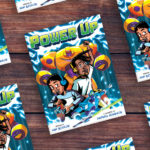When I taught first grade, one of my favorite writing units was the “How-to” unit. This unit was always engaging and excited every student. I realized students loved this unit so much because they were able to be an expert and write about it. Talk about a confidence booster! This writing unit was also a connection to a student’s home life. Whether it was a favorite recipe they made with a family member, directions on how to play a game, or maybe they finally mastered tying their shoes, no matter what they wrote about, their pride of being an expert was apparent when they shared their writing with the class.
The “How-to” writing unit was one of the smaller units that I taught, but this type of writing could use a little more credit seeing as “How-to” writing is such a large part of our adult world. If you think about it, a lot of our communication as adults involves “How-to” reading and writing. Some of the top Google searches of 2020 were “How-to” searches including: “How to cut men’s hair at home,” “How to wash your hands,” or “How to donate blood.”3 Social media is also a mecca of “How-to” content. The top social media sites of 2020 included Facebook, YouTube, Instagram, Tik Tok, and Pinterest.1All of these sites contain “How-to” content that is viewed by millions of people every day.
Looking back, I could have expanded this writing unit by digging deeper and offering more opportunity to extend the learning. With first graders, this is a great way to teach writing in sequence and thinking about your audience, but “How-to” writing also lends itself to much more. Planning, practicing, and communicating clearly is important when writing a “How-to.” If you have ever seen the YouTube video Exact Instructions Challenge, a dad made a peanut butter and jelly sandwich according to his son and daughter’s “How-to” directions.2 Let’s just say, it does not go as planned. The son and daughter learn that you cannot always assume someone’s prior knowledge, even with something as simple as a peanut butter and jelly sandwich. A lot of “How-to” content also involves audio, pictures, videos, or anything to help guide the learner. The possibilities are endless for extending the learning. If I am being honest, finding “How-to” information on the internet that is simple and correct is not always easy, so it’s important to teach these writing skills to students who may someday be presenting their information to future Googlers and DIYers.
Below are some fun “How-to” mentor texts you could use in elementary and secondary classrooms. In addition to books, consider bringing in other relevant resources. This could be a recipe from Pinterest, a “How-to” video from YouTube, or a relatable “How-to” Google search such as “how to make slime.”4
“How-to” Mentor Texts – Elementary

How to Read a Book by Kwame Alexander
How to Be a Virus Warrior by The Parent-Child Dino Research Team
Let’s Pop, Pop, Popcorn! by Cynthia Schumerth
How to Make a Friend by Stephen W. Martin, Olivia Aserr
How to Make a Pom-Pom Flyer: A 4D Book (Hands-On Science Fun) by Barbara Alpert
How to Wear a Sari by Darshana Khiani, Joanne Lew-Vriethoff
“How-to” Mentor Texts – Secondary

How to Pack for The End of The World by Michelle Falkoff
Guardians of The Planet: How to Be an Eco-Hero by Clive Gifford
Out! How to Be Your Authentic Self by Miles Mckenna
How to Remember Everything by Jacob Sager Weinstein
How to Build a Museum: Smithsonian’s National Museum of African American History and Culture (Smithsonian) By Tonya Bolden
How to Become an Accidental Genius by Frieda Wishinsky
References
1Clement, J. “Most Used Social Media 2020.” Statista, November 24, 2020. https://www.statista.com/statistics/272014/global-social-networks-ranked-by-number-of-users/.
2Exact Instructions Challenge PB&J Classroom Friendly, 2017. https://www.youtube.com/watch?v=FN2RM-CHkuI.
3“Google’s Year in Search.” Google Trends. Google. Accessed January 19, 2021. https://trends.google.com/trends/yis/2020/US/.
4Kid Friendly Slime Recipe | Michaels, 2017. https://www.youtube.com/watch?v=2T9xa7l8HC4.






